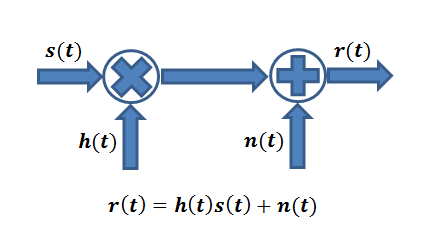I - Minimum Shift Keying (MSK) is a type of Continuous Phase Modulation (CPM) that has been used in many wireless communication systems. To be more precise it is Continuous Phase Frequency Shift Keying (CPFSK) with two frequencies f1 and f2. The frequency separation between the two tones is the minimum allowable while maintaining orthogonality and is equal to half the bit rate (or symbol rate, as both are the same). The frequency deviation is then given as Δf=Rb/4. The two tones have frequencies of fc±Δf where fc is the carrier frequency. MSK is sometimes also visualized as Offset QPSK (OQPSK) but we will not go into its details here.Continue reading Minimum Shift Keying Bit Error Rate in AWGN
All posts by Yasir Ahmed (aka John)
Pulse Amplitude Modulation Symbol Error Rate in AWGN
Pulse Amplitude Modulation (PAM) is a one dimensional or in other words real modulation. Simply put it is an extension of BPSK with M amplitude levels instead of two. This can be a bit confusing because BPSK can be looked at as a phase modulation and its natural extension must be QPSK or 8-PSK modulations. To remove this ambiguity lets call M-PAM an extension of simple amplitude modulation but with M levels. In the discussion below we consider M=4 but then extend it to the general case of M=2k (k=1,2,3…).
Continue reading Pulse Amplitude Modulation Symbol Error Rate in AWGNBeyond Massive MIMO
Recently Björnson and Marzetta in their publication on Antenna Arrays [1] discussed five possible future research directions. In their opinion Massive MIMO is no longer a theoretical concept and it is already being adopted in the industry. It is not uncommon to find 64 element antenna arrays being deployed in wireless communication systems. So we now need to look beyond Massive MIMO or MaMIMO as it is popularly referred to. Here are three possible future research directions that we find most interesting.
Continue reading Beyond Massive MIMOWireless Channel Modeling: Back to Fundamentals

When a wireless signal travels from a transmitter (Tx) to a receiver (Rx) it undergoes some changes. In simple terms the signal s(t) is scaled by a factor h(t) and noise n(t) is added at the receiver. Let’s take this discussion forward with a simple example. Suppose the Tx transmits one of two possible symbols, +1 or -1. In technical lingo this is called Binary Phase Shift Keying (BPSK). If the channel scaling factor is 0.1 we will either get a +0.1 or -0.1 at the Rx to which AWGN noise is added. The noise is random in nature (having a Gaussian distribution) but for simplicity we assume that it can have one of two values, +0.01 or -0.01.
Continue reading Wireless Channel Modeling: Back to Fundamentals60 GHz Millimeter Wave Band – Seems Like a Free Lunch
Let us start by first listing down the advantages of the 60 GHz Millimeter Wave Band, a band spread between 57 GHz and 64 GHz. This unlicensed band was first released in the US in 2001 but with limited allowance for transmit power (EIRP of 40 dBm). Later on, in 2013, this limit was increased to allow for greater transmit power (EIRP of 82 dBm) and larger range. The higher EIRP can be achieved with an antenna gain of 51 dBi or higher (EIRP is simply the product of transmit power and antenna gain). But first the advantages:
- Unlicensed band means you do not have to pay for using the frequencies in this band.
- Wide bandwidth of 7 GHz allows high data rate transmissions. Remember Shannon Capacity Theorem?
- High atmospheric absorption resulting in greater path loss (up to 20 dB/km) and shorter range. This means lesser co-channel interference and higher reuse factor.
- Smaller antenna sizes allowing for multiple antennas to be put together in the form of an array providing high gain.
- This band is quite mature and electronic components are cheap and easily available.
Massive MIMO and Antenna Correlation
Some Background
In a previous post we calculated the Bit Error Rate (BER) of a Massive MIMO system using two different channel models namely deterministic and probabilistic. The deterministic channel model is derived from the geometry of the array (ULA in this case) and the distribution of users in the cell. Whereas probabilistic channel model assumes that the channel is flat fading and can be modeled, between each transmit receive pair, as a complex, circularly symmetric, Gaussian random variable with mean of zero and variance of 0.5 per dimension.
Continue reading Massive MIMO and Antenna Correlation